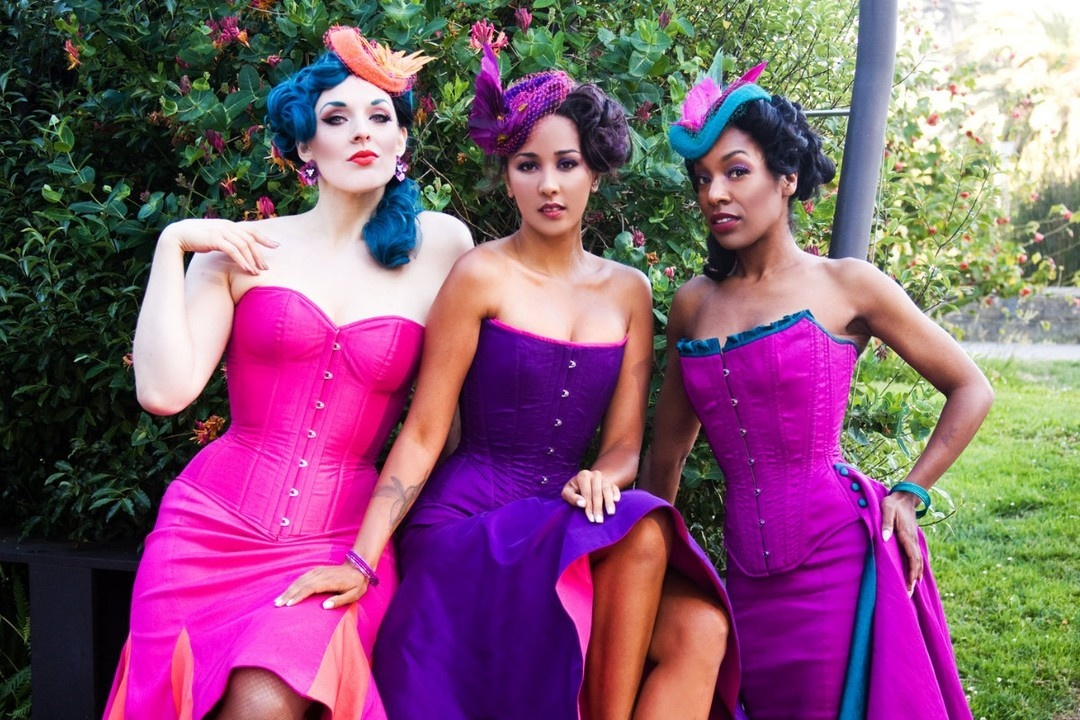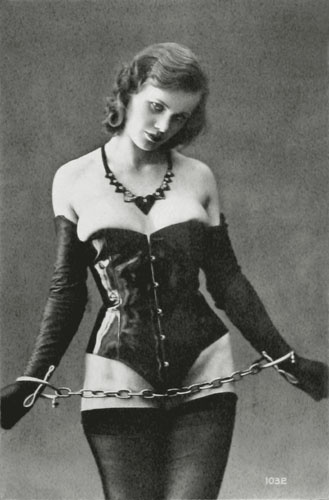

Login
Log in if you have an account
Register
Having an account with us will allow you to check out faster in the future, store multiple addresses, view and track your orders in your account, and more.
Create an accountCorset History V: Corsets in Postmodern Fashion


Ensembles from the Technicolor Sirens couture collection by Dark Garden. Photo by Gina Barbara
Although corsets are no longer part of the average woman’s everyday wear, they remain a great source of inspiration for subcultural styles and contemporary designers — including Dark Garden Corsetry!
This is the last installment of a blog post series covering how the history of the corset, where our goal has been to demonstrate how historical corsets inform Dark Garden’s modern designs. Previous posts began with the emergence of “boned bodies” in Renaissance Europe, how they transformed into stays over the 17th and 18th centuries, and how technological advancements influenced ever-evolving corsets throughout the 19th century. Most recently, we discussed how flexible girdles and corselets were worn during the early and mid-20th centuries to help women achieve a smooth, ideal figure. However, cultural movements coming out of the 1960s, ‘70s, and ‘80s created a preference for the natural body without assistance from body-molding shapewear. Thus, the boned corset lost its prominence as a necessary women’s undergarment.
|
Yet the corset has never entirely disappeared. Corsets remained popular among sexual fetishists, especially those who practiced BDSM, which is supported by photo evidence from as early as the 1930s. As fetish costume, the corset could play two distinct roles in this community: as a form of rigid armor for the dominatrix, and a form of feminizing punishment for the submissive. Bettie Page, a well-known 1950s pin-up model, was photographed wearing corsets in BDSM situations. The restrictive element of tight-lacing also appeared to body performers like Fakir Musafar, who was famously photographed in 1959 wearing a corset with a 19-inch waist. During the 1970s and 1980s, corsets became more visible through subcultures like punks and goths. While some of these subculturalists may have overlapped with the BDSM community, others may have worn the garment because of its associations with body modification and fashion history. Particularly in the goth subculture, Victorian-inspired corsets were popular among all genders as men were often praised for androgyny and women for hyper-femininity. These corsets were not only worn in a private context, or underneath clothing, but rebelliously out in the open. After the 1960s, subcultural and street styles were increasingly important sources of inspiration for fashion designers. By the late 1980s, modern interpretations of traditional corsetry appeared on the runways, by designers including Vivienne Westwood and Jean Paul Gaultier. Gaultier is responsible for outfitting Madonna in her now-iconic bullet-bra corset costume for the 1990 Blond Ambition tour. |
Ostra Studios/Biederer Studio, photograph of a woman wearing a corset and chains, c. 1930 |
|
The French designer was inspired by his grandmother’s corset and a childhood memory of helping her lace it. It was then that his grandmother told him about the practice of tight-lacing, which fascinated him. Gaultier continued to experiment with corsetry throughout the 1990s and into the present day. The mid-1990s was the true era of spectacular runway shows, and many other notable designers also experimented with historically-inspired corsets, including John Galliano and Thierry Mugler. Both of these couturiers collaborated with notable corset-maker Mr. Pearl. (You can read about our own collaboration with Mr Pearl on our Patreon!)
|
Corsets remained popular among subculture groups, but their demand increased as they continued to be pictured on international supermodels. It was in this context that the founder of Dark Garden Unique Corsetry, Autumn Adamme, began selling corsets in 1989. She observed that not many retailers could supply comfortable, high-quality corsets that she herself wanted to own. Dark Garden’s designs were also favored by high-profile corset-wearers such as Cathy Jung, who holds the Guinness World Record for the smallest waist on a living person, and burlesque performer Dita von Teese. Von Teese commissioned her first Dark Garden corset in 1996 and wore pieces by Dark Garden on the cover of Playboy in 2002, 2015, and 2016. Due to their inherent glamor and drama, corsetry is a constant runway and red carpet trend into the 2020s. In 2022, corset design elements like boning were featured in runway collections by Christian Siriano, Fendi, Gucci, Junya Watanabe, Olivier Theyskens, Versace, and so many more. And who can forget the extremely tight-laced wet look ensemble Kim Kardashian wore to the Camp-themed Met Gala in 2019? Our own Autumn Adamme has assisted in fitting other celebrities into their glove-fitting corsets for designers such as Jeremy Scott. In short: throughout the years, trends have come and gone, but corsets will simply never go out of style. |
 Dita Von Teese wears her bespoke Dark Garden corset on the 2002 cover of Playboy magazine. |



